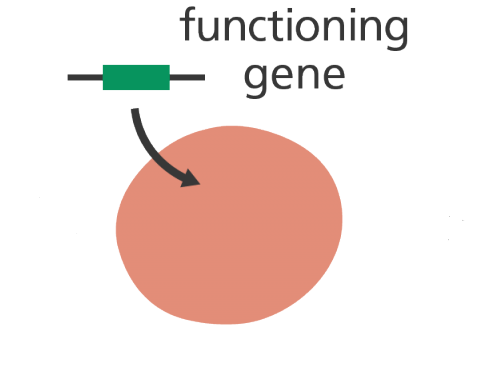Gene therapy is an experimental discipline or research that uses functional gene (i.e. therapeutic DNA) to repair defective genes in genetic disease patients; and this growing field of molecular medicine is usually undertaken using modified nucleic acid molecules through a series of steps. Conventional medicine utilizes oral and parenteral drug administration as well as surgery and chemotherapy to treat infectious diseases, but this is not the case for gene therapy which normally makes use of gene delivery techniques that delivers specific and functional gene copies into the body of individuals with genetic disorders.
The transfer of genetically modified genes or DNA into the body especially for curative purposes requires several critical steps in order to ensure the success of the process. Most gene therapy applications are mainly based on manipulation of the somatic cells with little or no attempt made on altering the individual’s germ-line (i.e. the gamete cells). While somatic gene therapy (in which functional genes are inserted into the body) may be permitted in some quarters, germ line gene therapy (that envisages the manipulation of gamete cells) is not yet allowed anywhere in the world due to some ethical issues surrounding the later.
Genetic modifications in somatic gene therapy techniques cannot be passed on to the next generation (i.e. from parents to offspring’s) but any alteration in the gamete cells (i.e. the egg and sperm) as is being proposed by the germ line gene therapy can be passed on to the next generation. Some of the basic steps to be taken when gene therapy is anticipated are as follows:
- Identification of candidate genetic disease: The genetic disorder especially those that cannot be successfully treated with available conventional medical practices and the faulty cells must be identified and accessible.
- Gene cloning: Gene cloning is a molecular biology procedure that is used to obtain many copies of a particular gene or piece of DNA. The genetic basis of the molecular disease must be understood and determined through the identification of the genes that encodes for the defective genes so that a mutant functional gene can be generated via rDNA technology (e.g. gene cloning).
- Determining disease pathophysiology: The pathophysiology of the molecular disease should be determined beforehand so that the cellular sites for the insertion of the functional gene or DNA required to correct the faulty genes can be ascertained and well targeted in the process.
- Identification of gene expression: Gene expression in the cell is often identified via the production or synthesis of particular protein molecules which the gene encodes. It is critical that the tools required for identifying the expression of the correct genes in vivo be available and used to determine the production of specific protein molecules in the host receiving therapeutic DNA or genes.
- Pre-clinical in vitro and vivo tests: Gene therapy is still an experimental discipline, and thus it is being undertaken mainly at clinical trial levels but with utmost caution. It is critical to conduct series of in vitro and in vivo non-clinical and clinical trials whenever gene therapy techniques are anticipated so that optimum result will be obtained. The mode of delivery of the therapeutic DNA or gene into the desired cells or tissues in the body (which is still a challenge in gene therapy techniques) must also be worked out to be efficient and available.
References
Alberts B, Bray D, Johnson A, Lewis J, Raff M, Roberts K and Walter P (1998). Essential Cell Biology: An Introduction to the Molecular Biology of the Cell. Third edition. Garland Publishing Inc., New York.
Dale J (2003). Molecular genetics of bacteria. Jeremy W. Dale and Simon Park (4th eds.). John Wiley & Sons Ltd, West Sussex, UK.
Edelstein, M. L., Abedi, M. R., Wixon, J., and Edelstein, R. M. (2004). Gene therapy clinical trials worldwide 1989-2004—an overview. J Gene Med, 6: 597-602.
Ferrua, F.; Brigida, I.; Aiuti, A. (2010). Update on gene therapy for adenosine deaminase-deficient severe combined immunodeficiency. Current Opinion in Allergy and Clinical Immunology. 10 (6): 551–556.
Gardlík R, Pálffy R, Hodosy J, Lukács J, Turna J, Celec P; Pálffy; Hodosy; Lukács; Turna; Celec (2005). Vectors and delivery systems in gene therapy. Med Sci Monit. 11 (4): RA110–21.
Horn PA, Morris JC, Neff T, Kiem HP; Morris; Neff; Kiem (2004). Stem cell gene transfer—efficacy and safety in large animal studies. Mol. Ther. 10 (3): 417–31.
S Li and L Huang (2000). Nonviral gene therapy: promises and challenges. Gene Therapy, 7:31-34. www.nature.com/gt
Salmons B, Günzburg WH; Günzburg (1993). Targeting of retroviral vectors for gene therapy. Hum Gene Ther. 4 (2): 129–41.
Sambrook, J., Russell, D.W. (2001). Molecular Cloning: a Laboratory Manual, 3rd edn. Cold Spring Harbor Laboratory Press, New York.
Sheridan C (2011). Gene therapy finds its niche. Nature Biotechnology. 29 (2): 121–128.
Tamarin Robert H (2002). Principles of Genetics. Seventh edition. Tata McGraw-Hill Publishing Co Ltd, Delhi.
Twyman R.M (1998). Advanced Molecular Biology: A Concise Reference. Bios Scientific Publishers. Oxford, UK.
Vannucci, L; Lai, M; Chiuppesi, F; Ceccherini-Nelli, L; Pistello, M (2013). Viral vectors: A look back and ahead on gene transfer technology. The new microbiologica. 36 (1): 1–22.
Discover more from #1 Microbiology Resource Hub
Subscribe to get the latest posts to your email.



